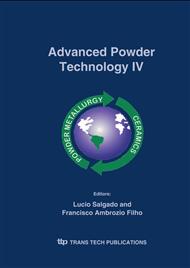p.648
p.654
p.658
p.663
p.669
p.676
p.681
p.691
p.697
Physical Characterization of K-Doped 0.9PMN-0.1PT Synthesized by an Association of the Columbite Route and the Polymeric Precursor Method
Abstract:
The solid solution 0.9PbMg1/3Nb2/3O3-0.1PbTiO3 is one of the most widely investigated relaxor ceramic, because of its high dielectric constant and low sintering temperatures. PMN-PT powders containing single perovskite phase were prepared by using a Ti-modified columbite precursor obtained by the polymeric precursor method. Such precursor reacts directly with stoichiometric amount of PbO to obtain pyrochlore-free PMNPT powders. The structural effects of K additive included in the columbite precursor and 0.9PMN-0.1PT powders were also studied. The phase formation at each processing step was verified by XRD analysis, being these results used for the structural refinement by the Rietveld method. It was verified the addition of K in the columbite precursor promotes a slight increasing in the powder crystallinity. There was not a decrease in the amount of perovskite phase PMN-PT for 1mol% of K, and the particle and grain size were reduced, making this additive a powerful tool for grain size control.
Info:
Periodical:
Pages:
669-675
Citation:
Online since:
November 2005
Authors:
Keywords:
Price:
Сopyright:
© 2005 Trans Tech Publications Ltd. All Rights Reserved
Share:
Citation:


